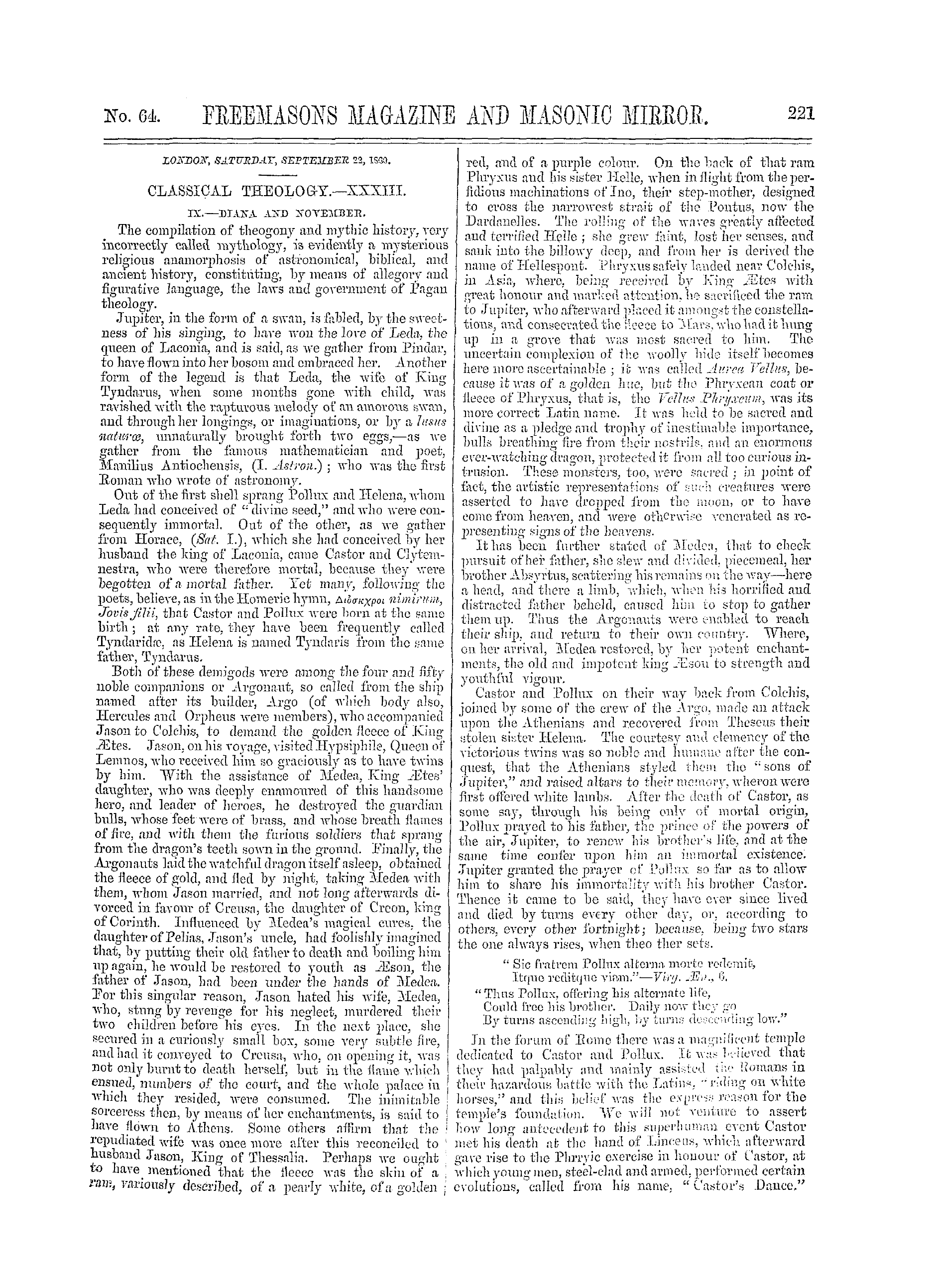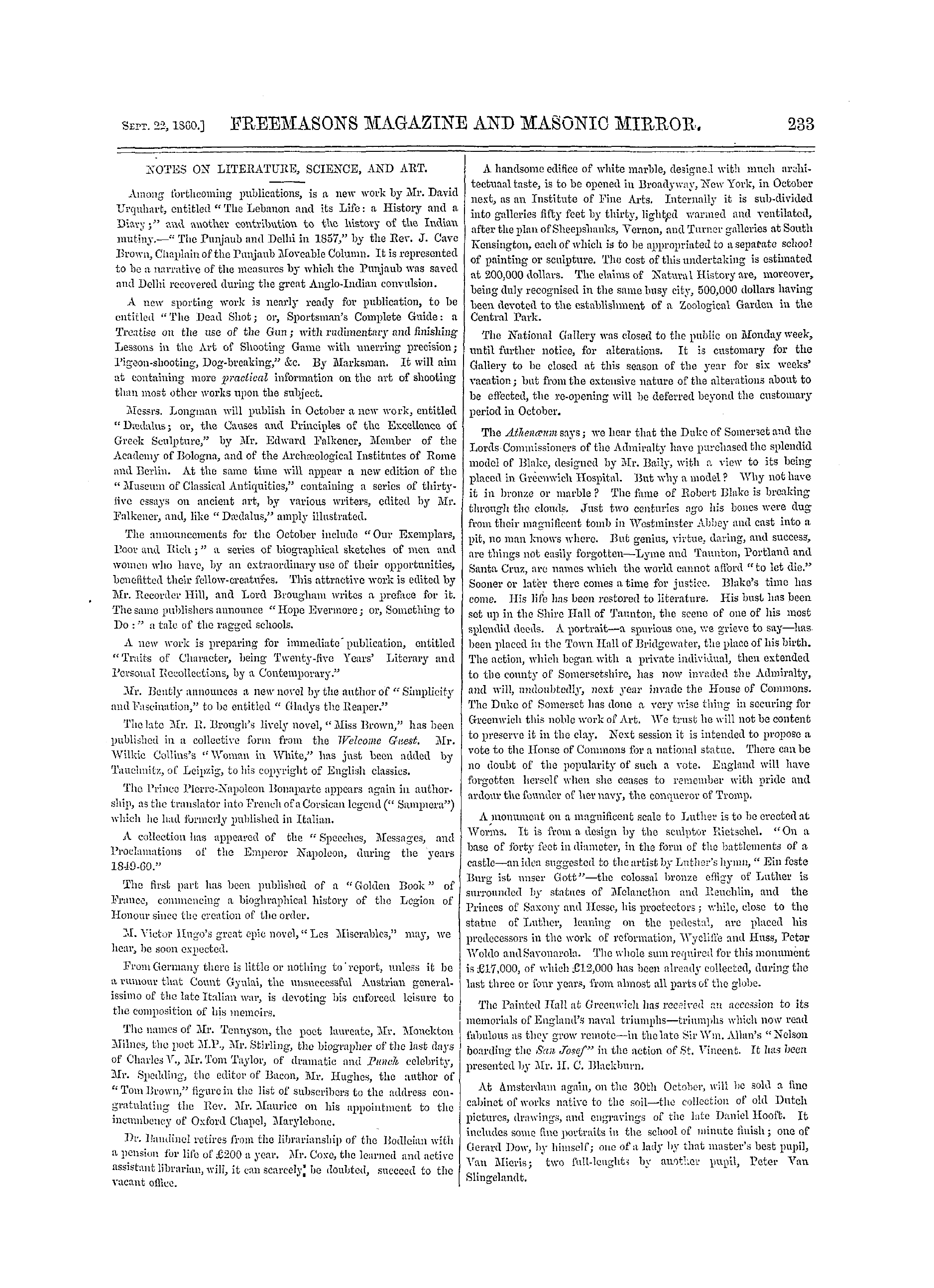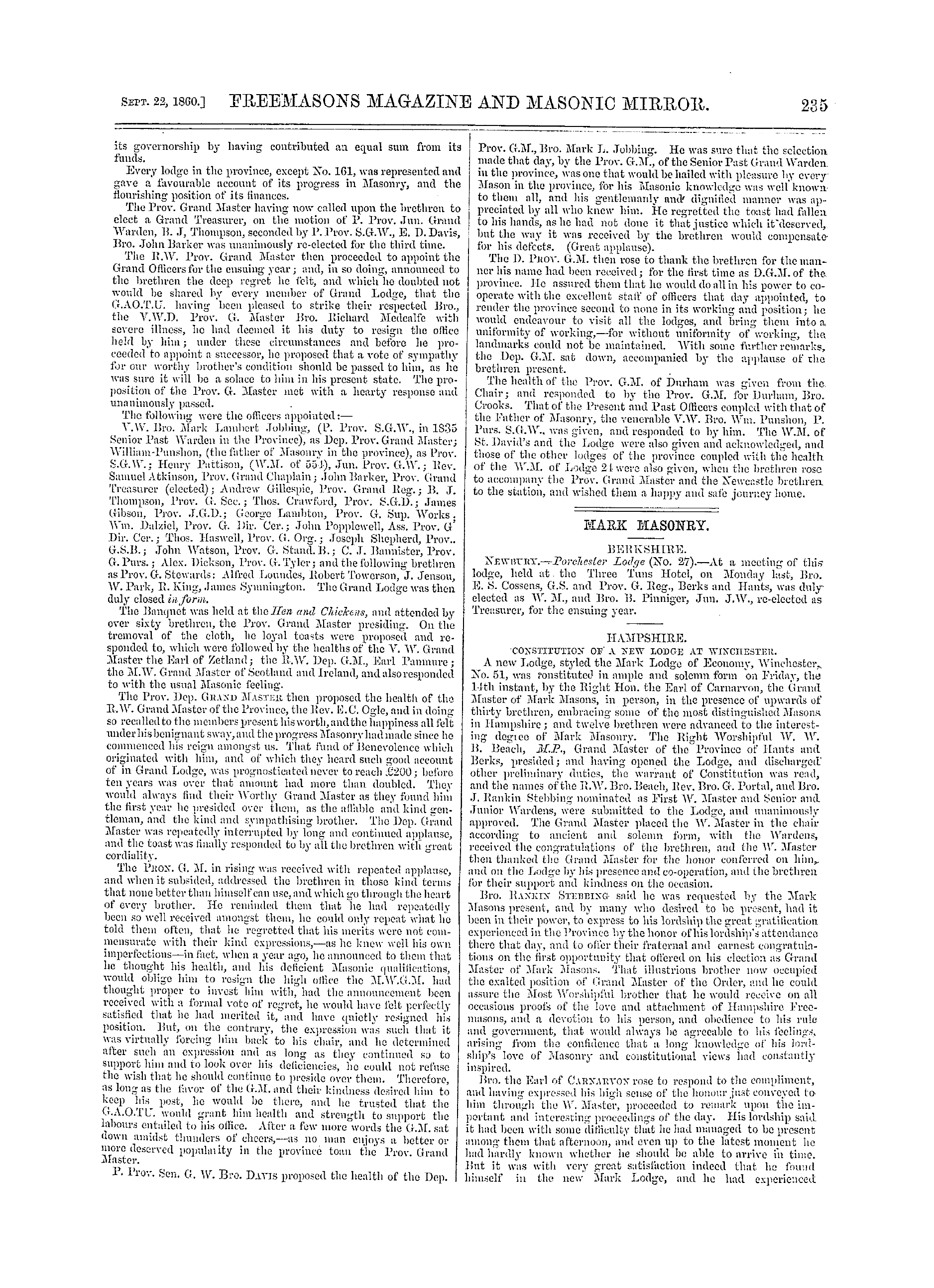-
Articles/Ads
Article CLASSICAL THEOLOGY.—XXXIII. ← Page 2 of 2 Article MASTER-PIECES OF THE ARCHITECTURE OF DIFFERENT NATIONS. Page 1 of 2 →
Note: This text has been automatically extracted via Optical Character Recognition (OCR) software.
Classical Theology.—Xxxiii.
Pliny ( Ap . Nat . Com . vii . 5—1 ) may here be consulted as sufficient reference . Agamemnon , king of the Argivi , ivho , by the unanimous consent of the Grecians , was appointed commanderin-chief of their expedition against the Trojans , killed by chance , in the country of Aulis , a deer , appertaining
or devoutly dedicated to Diana . "Whereat , declares Euripides , ( called Afisor / i / nes , from his hatred of women ) , in one of the extant nineteen of his seventy-five tragedies , "Iphigenia , " the goddess became intensely angry , and caused such a lull as to becalm , as though spell-bound , the Grecian ships under Agamemnon ' s commandivhich
, were on their way to Troy . In this dilemma the augurs were consulted , whose answers determined an absolute necessity of the winds being propitiated , and Diana ingratiated to their favour with the atoning blood , in other words , the life of Agamemnon . Expediency in diplomac is the ingenious realization of a subterfuge . Ulysses
was forthwith chosen ambassador to tho court of the Argivi under the pretext of bringing away I phigenia , the daughter of Agamemnon , from the Queen her mother , to be united to Achilles . This device succeeded ; but whilst the beauteous young virgin stood pale ancl trembling , at the altar , not to be married , but to be immolated ,
the goddess conceived a deep compassion for her , and preteniaturall j ' - substituted a hart in her stead . Iphigenia herself appears to have been conveyed to the peninsula Chersonesus Taurica , where Thyas , King of the Tauri , compelled her to preside over those terrible sacrifices of Diana Taurica , which could only be solemnized with the blood of human slaughter .
Clytemnestra , with the nelp of JEgistheus , her leman , murdered king Agamemnon , her husband , on his return from the conquest of Troy ; and the King ' s son Orestes , would have shared the same fate as his lather Agamenon , had not his sister , Eleetra , accomplished his escape from the ver ; , - jaws of destruction by sending him on a secret journey to Strophiusthe King of Phocisfrom whom he
, , received welcome and protection . At the expiration of twelve years he returned to his . own kingdom , and delivered it out of the regicidal and usurping hands of Cly temnestra and JE gistheus , by despatching both of them witli the sword of retribution . He also killed Pyrrluis , regardless of his sanctuary , in . the temple of
Apollo , for having carried oil' and married Uermione , the daughter of Menelaus and Helena , who had been previously promised in marriage to himself . Thereupon Apollo charged the Turies to torment him ; and from their punishment he could find no release or respite , until Pyladeshis faithful friendthe companion in all his
, , dangers—of whom mutually it was said thoy would lay down their lives as one for each other—the fraternal Pylades brought him to the the temple of Diana Taurica , who admitted at her altar the expiation of his sacrilegious crime , Orestes' sister , Iphigenia , ivho was then , according to Euripideshigh priestess ofthe goddess in the Taurica
, Clieri .-onesus , recognising her brother ancl preserved him . " Whereupon Thyas was killed , and the real image of the goddess ivas discovered hidden amidst a bundle of sticks ( fasci ;) , whence she received the cognomen of Diana Eascelis . The ancient statue of this
"Hecate by night adored with shrieks—¦" as Virgil hath it , " Nbcturnisquc Itocatc triviis ululate per urbesy ' Jlim ' ul ix ., was carried away and replaced by a new figure of some more Grecian , or Argiviau . Diana Pascelis , ipasma that is Diana with a nosegay , or diadem ; yet still ivith more probability , the surname was derived from the Greek and Latin words implying either to enchant or tofascinate .
Master-Pieces Of The Architecture Of Different Nations.
MASTER-PIECES OF THE ARCHITECTURE OF DIFFERENT NATIONS .
BZ J . a . LEGBAjSeD . CTCLOMEAIS' COSSTRUCTIOK" . Three princijial things are to be considered with respect to this architecture : firstly , its application ; secondl y its construction ; and thirdly , its history . Its very simple application is in conformity with the
nature of the edifices in which it is employed . It has hitherto been found onl yin fortifications , castellated forts , isolated towers , side walls along roads , maritime quays , and several rivers , peribolos or supporting walks round earth tombs , and lastly , pnixes ; for it is thus that certain edifices must be named which aro formed on a
semicircular plan , after the example of a few theatres , in ivhich , as in those of Athens and of Delos , were held assemblages of the ancient people , who were the authors of those constructions . The names are to this day given of more than 150 towns , in Greece , in Asia Minor , in Thrace ( taken in its
most ancient extent ) , in the islands in the Archipelago and the Mediterranean , and finall y in Italy , where Cycoplean monuments have been observed . * Of these towns , the names will be given here only of Myccnto , Argos , Tyrinthus and Nauplia , because Emi pidesStraboand Pausanias saidin speaking
, , , specially of these four cities , that their walls were the work of tbe Cyclops . The perfect identity which these monuments present , when compared with those of Italy , justifies tho correctness of the classical denomination which M . Louis Petit Eaclel gives to all monuments of the same kind . The architecture of these monuments is
regulated solely according to tiie news 01 military tactics : everything in it has strength and common sense ; there is nothing in it merely for elegance ; nevertheless , and with very good reason , Pausanias compares these monuments to all that the Egyptians created that is not admirable . Pollux says , in speaking ofthe Cyclopean structure ofthe pnix of Athens , that it bears the character of the most ancient times .
The situation ofthe towns , both in Italy and Greece , where this Cyclopean Architecture is observed , is remarkable , inasmuch as they are invariably situated , on the summits of mountains , ancl it is there where Homer places the establishments ofthe Cyclops and of the Lastrygons , and Theocritus , those of the Pelasgi . The founders of these towns laid down five lines oi
fortifications round them as well as around the mountain , and formed a commmimication from one to the other by means of passages dug out of the solid rock of a very hard marble . The doors were not arched , but had jambs and lintels , the calculated solidity of which is immense . Cyclopean construction is essentially formed of
irregular polygonal blocks ; not of that irregularity which reveals ignorance or rather work done iu a hurry , but an irregularity in which there is method , and which was intended—the aim being to prevent the ruin of the wall , byenabling fresh materials to be supplied when required . The monuments of the latest date show that the
builders did not- at first arrive at this perfection ; for there are some of these monuments in the most ancient cities of Greece , in which the perip hery of each block ia positively the polygon ivhich the calcareous stone naturally describes by the simple mechanism of its formation ;
Note: This text has been automatically extracted via Optical Character Recognition (OCR) software.
Classical Theology.—Xxxiii.
Pliny ( Ap . Nat . Com . vii . 5—1 ) may here be consulted as sufficient reference . Agamemnon , king of the Argivi , ivho , by the unanimous consent of the Grecians , was appointed commanderin-chief of their expedition against the Trojans , killed by chance , in the country of Aulis , a deer , appertaining
or devoutly dedicated to Diana . "Whereat , declares Euripides , ( called Afisor / i / nes , from his hatred of women ) , in one of the extant nineteen of his seventy-five tragedies , "Iphigenia , " the goddess became intensely angry , and caused such a lull as to becalm , as though spell-bound , the Grecian ships under Agamemnon ' s commandivhich
, were on their way to Troy . In this dilemma the augurs were consulted , whose answers determined an absolute necessity of the winds being propitiated , and Diana ingratiated to their favour with the atoning blood , in other words , the life of Agamemnon . Expediency in diplomac is the ingenious realization of a subterfuge . Ulysses
was forthwith chosen ambassador to tho court of the Argivi under the pretext of bringing away I phigenia , the daughter of Agamemnon , from the Queen her mother , to be united to Achilles . This device succeeded ; but whilst the beauteous young virgin stood pale ancl trembling , at the altar , not to be married , but to be immolated ,
the goddess conceived a deep compassion for her , and preteniaturall j ' - substituted a hart in her stead . Iphigenia herself appears to have been conveyed to the peninsula Chersonesus Taurica , where Thyas , King of the Tauri , compelled her to preside over those terrible sacrifices of Diana Taurica , which could only be solemnized with the blood of human slaughter .
Clytemnestra , with the nelp of JEgistheus , her leman , murdered king Agamemnon , her husband , on his return from the conquest of Troy ; and the King ' s son Orestes , would have shared the same fate as his lather Agamenon , had not his sister , Eleetra , accomplished his escape from the ver ; , - jaws of destruction by sending him on a secret journey to Strophiusthe King of Phocisfrom whom he
, , received welcome and protection . At the expiration of twelve years he returned to his . own kingdom , and delivered it out of the regicidal and usurping hands of Cly temnestra and JE gistheus , by despatching both of them witli the sword of retribution . He also killed Pyrrluis , regardless of his sanctuary , in . the temple of
Apollo , for having carried oil' and married Uermione , the daughter of Menelaus and Helena , who had been previously promised in marriage to himself . Thereupon Apollo charged the Turies to torment him ; and from their punishment he could find no release or respite , until Pyladeshis faithful friendthe companion in all his
, , dangers—of whom mutually it was said thoy would lay down their lives as one for each other—the fraternal Pylades brought him to the the temple of Diana Taurica , who admitted at her altar the expiation of his sacrilegious crime , Orestes' sister , Iphigenia , ivho was then , according to Euripideshigh priestess ofthe goddess in the Taurica
, Clieri .-onesus , recognising her brother ancl preserved him . " Whereupon Thyas was killed , and the real image of the goddess ivas discovered hidden amidst a bundle of sticks ( fasci ;) , whence she received the cognomen of Diana Eascelis . The ancient statue of this
"Hecate by night adored with shrieks—¦" as Virgil hath it , " Nbcturnisquc Itocatc triviis ululate per urbesy ' Jlim ' ul ix ., was carried away and replaced by a new figure of some more Grecian , or Argiviau . Diana Pascelis , ipasma that is Diana with a nosegay , or diadem ; yet still ivith more probability , the surname was derived from the Greek and Latin words implying either to enchant or tofascinate .
Master-Pieces Of The Architecture Of Different Nations.
MASTER-PIECES OF THE ARCHITECTURE OF DIFFERENT NATIONS .
BZ J . a . LEGBAjSeD . CTCLOMEAIS' COSSTRUCTIOK" . Three princijial things are to be considered with respect to this architecture : firstly , its application ; secondl y its construction ; and thirdly , its history . Its very simple application is in conformity with the
nature of the edifices in which it is employed . It has hitherto been found onl yin fortifications , castellated forts , isolated towers , side walls along roads , maritime quays , and several rivers , peribolos or supporting walks round earth tombs , and lastly , pnixes ; for it is thus that certain edifices must be named which aro formed on a
semicircular plan , after the example of a few theatres , in ivhich , as in those of Athens and of Delos , were held assemblages of the ancient people , who were the authors of those constructions . The names are to this day given of more than 150 towns , in Greece , in Asia Minor , in Thrace ( taken in its
most ancient extent ) , in the islands in the Archipelago and the Mediterranean , and finall y in Italy , where Cycoplean monuments have been observed . * Of these towns , the names will be given here only of Myccnto , Argos , Tyrinthus and Nauplia , because Emi pidesStraboand Pausanias saidin speaking
, , , specially of these four cities , that their walls were the work of tbe Cyclops . The perfect identity which these monuments present , when compared with those of Italy , justifies tho correctness of the classical denomination which M . Louis Petit Eaclel gives to all monuments of the same kind . The architecture of these monuments is
regulated solely according to tiie news 01 military tactics : everything in it has strength and common sense ; there is nothing in it merely for elegance ; nevertheless , and with very good reason , Pausanias compares these monuments to all that the Egyptians created that is not admirable . Pollux says , in speaking ofthe Cyclopean structure ofthe pnix of Athens , that it bears the character of the most ancient times .
The situation ofthe towns , both in Italy and Greece , where this Cyclopean Architecture is observed , is remarkable , inasmuch as they are invariably situated , on the summits of mountains , ancl it is there where Homer places the establishments ofthe Cyclops and of the Lastrygons , and Theocritus , those of the Pelasgi . The founders of these towns laid down five lines oi
fortifications round them as well as around the mountain , and formed a commmimication from one to the other by means of passages dug out of the solid rock of a very hard marble . The doors were not arched , but had jambs and lintels , the calculated solidity of which is immense . Cyclopean construction is essentially formed of
irregular polygonal blocks ; not of that irregularity which reveals ignorance or rather work done iu a hurry , but an irregularity in which there is method , and which was intended—the aim being to prevent the ruin of the wall , byenabling fresh materials to be supplied when required . The monuments of the latest date show that the
builders did not- at first arrive at this perfection ; for there are some of these monuments in the most ancient cities of Greece , in which the perip hery of each block ia positively the polygon ivhich the calcareous stone naturally describes by the simple mechanism of its formation ;



















